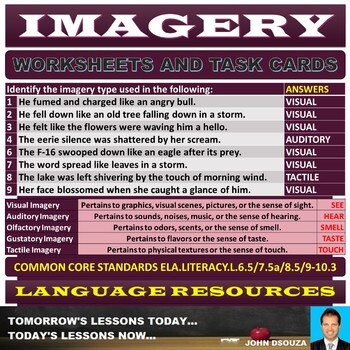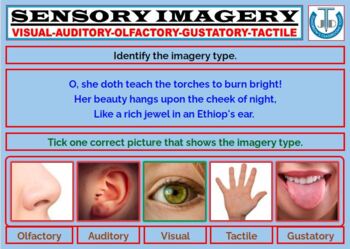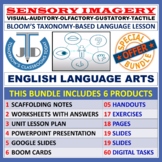SENSORY IMAGERY - AUDITORY, VISUAL, OLFACTORY, GUSTATORY, TACTILE: WORKSHEETS
JOHN DSOUZA
1.1k Followers
Grade Levels
6th - 10th
Resource Type
Standards
CCSSRL.8.4
CCSSW.8.3d
CCSSL.8.5
CCSSL.9-10.3
Formats Included
- Word Document File
Pages
17 pages
JOHN DSOUZA
1.1k Followers
Also included in
- This bundle of 11 products (Worksheets with Answers) is perfect for teaching Figures of Speech - Simile, Metaphor, Hyperbole, Analogy, Personification, Sensory Imagery, Irony, Synecdoche, Metonymy, Alliteration, Onomatopoeia, Repetition, Rhyme, Oxymoron and Idioms. These no prep activities would bePrice $18.90Original Price $27.00Save $8.10
- These bundled resources are perfect for teaching Sensory Imagery – Auditory, Visual, Olfactory, Gustatory and Tactile. These no prep activities would be great for English lessons or English centers. Your students will love these ELA Boom Cards, Google Slides, PPT, Unit Plan and Worksheets.After compPrice $12.60Original Price $18.00Save $5.40
Description
These Worksheets with Answers are perfect for teaching Sensory Imagery – Auditory, Visual, Olfactory, Gustatory and Tactile. These no prep activities would be great for ELA lessons or ELA centers. Your students will love these exercises that are carefully planned for student engagement.
After attempting these New Bloom’s Taxonomy-based activities students will be able to:
- Identify the correct definition of imagery types – visual, auditory, olfactory, gustatory and tactile.
- Examine word-pictures used as imagery in a given text.
- Show examples of writing that allow readers to visualise, hear, touch, taste or smell in their imagination.
- Interpret word-images sensory imagery creates in a text and explain the author’s purpose in using it.
- Evaluate author’s use of imagery to create word images in a text.
- Use sensory imagery to create vivid descriptions and word images in writing.
This Download Includes:
- EXERCISE 1: Match the imagery types (1-5) with their meaning (A-E).
- EXERCISE 2: Fill in the blanks to check your understanding of the meaning of imagery types.
- EXERCISE 3: Match the imagery types (1-5) with the images (A-E) they represent.
- EXERCISE 4: Watch the video – What is Imagery? – and state what sense the author is appealing to in the following sentences.
- EXERCISE 5: Identify the imagery type used in the following sentences.
- EXERCISE 6: Identify the sensory imagery (visual, auditory, olfactory, tactile and gustatory) used in the following description.
- EXERCISE 7: Answer the following questions to identify the imagery types.
- EXERCISE 8: Answer the questions to state what sense is being appealed to in the following instances.
- EXERCISE 9: Answer the following questions to identify the word-images created by sensory imagery.
- EXERCISE 10: Answer the following questions to identify the instances where imagery is used with other figures of speech.
- EXERCISE 11: Identify the type of imagery used and state how.
- EXERCISE 12: Follow the PEE (Point-Evidence-Explain) model to analyse the poet’s use of imagery in the poems.
- EXERCISE 13: Follow the PEEL model to explain the reader impact of the use of imagery in the poems.
- EXERCISE 14: Describe the following images to create word-images. Follow the instructions and use the given descriptors.
- EXERCISE 15: Use the given descriptive vocabulary to describe the beach.
- EXERCISE 16: Use your knowledge of IMAGERY TYPES to write on one of the following. Follow the rubrics.
- EXERCISE 17: Describe the image taking into account what you see, hear, feel, taste and smell. Use your imagination to comment on what you would be seeing, hearing, touching, tasting and feeling. Make sure you use at least five each sensory words from the list for every sense.
Here are some other possible uses for these in your classroom:
- To challenge early finishers
- For effective tutoring
- As ESL stations and sub tubs
- As holiday work and homework
- For small group collaborations
- For an end of unit assessments
- For reinforcement and enrichment
More Figurative Language Resources by the same Author:
- Rhetorical Comparison Devices
- Rhetorical Sound Devices
- Sensory Imagery
- Elegy
- Irony Types
- Oxymoron
- Personification
- Synecdoche vs Metonymy
This is what teachers say about these resources:
- INFERRING MEANING WORKSHEETS WITH ANSWERS - Comment from Patrice Thornton: "My students benefited from this resource during speech therapy sessions." Rating: 4/5 (very satisfied)
- COMPLEX SENTENCE STRUCTURE: 21 WORKSHEETS WITH ANSWERS - Comment from TouchofTechSLP: "This was helpful for working on complex sentences with my speech students" Rating: 5/5 (extremely satisfied)
- VERBAL PHRASES: 14 WORKSHEETS WITH ANSWERS - Comment from ELLPro: "My students had a good time interacting with this resource thank you!" Rating: 4/5 (very satisfied)
- HYPHENS AND DASHES - PUNCTUATION: WORKSHEETS WITH ANSWERS - comment from Heather Landry: "My students enjoyed this lesson. They weren't well versed on hyphens and dashes before, but these resources helped change that." Rating: 5/5 (extremely satisfied)
- NOUN PHRASES: 20 WORKSHEETS WITH ANSWERS from ELLPro. Comment: "My students had a good time interacting with this resource thank you!" Rating: 4/5 (very satisfied)
- ADVERTISEMENT DESIGN TASK CARDS AND EXERCISES - Comment from Margie Batt: "Well thought out quality resource that aligned with my classroom strategies." Rating: 5/5 (extremely satisfied)
- IRONY WORKSHEETS AND TASK CARDS - Comment from Cheryl Tilles: "Very helpful during our study of irony. The task cards offer great practice." Rating: 5/5 (extremely satisfied)
- PREPOSITIONAL PHRASES: 20 WORKSHEETS WITH ANSWERS - Mrs Foleys English Extreme: "Great for 7th grade writing" Rating: 4/5 (very satisfied)
- ADVERBIAL PHRASES: 17 WORKSHEETS WITH ANSWERS - Patrick Howard: As we stepped into remote learning I was looking for ways for my students to interact with the parts of sentences at home. These worksheets really helped to solidify their working knowledge of adverbials and prepositional phrases, and the role they play in sentences. Rating: 5/5 (extremely satisfied)
- PROOFREADING WORKSHEETS WITH ANSWERS - Milloni Shah: Great proofreading practice for my students. Rating: 4/5 (very satisfied)
- PARTS OF SPEECH WORKSHEETS WITH ANSWERS - Courtney Flournoy: A great way to teach the language standards. Rating: 5/5 (extremely satisfied)
- IMAGERY WORKSHEETS WITH ANSWERS - Stefani Karlsson: My students loved this resource and the activities included with it. They were engaged, learning and having fun! Thanks for your hard work. It is greatly appreciated. Rating: 5/5 (extremely satisfied)
- COMPOUND ADJECTIVES: WORKSHEETS WITH ANSWERS - Easy to use. Plenty of examples and activities. - Nat Mack
- PARAGRAPH WRITING - 12 WORKSHEETS WITH ANSWERS: Perfect for assisting students in their paragraph and essay writing. - Martin Distelhorst
- ADJECTIVE PHRASES WORKSHEETS WITH ANSWERS: Perfect for what I needed. - Laura T.
- PUNCTUATION WORKSHEETS WITH ANSWERS: The content was great, and I appreciate that all of the advanced punctuation marks were assessed in one place. - Tiffani Rooney
- SPOKEN VS WRITTEN ENGLISH WORKSHEETS AND TASK CARDS: Excellent resource for the price. Saved me tons of time! - Crystal Louden
- SENTENCE STRUCTURE - 11 WORKSHEETS WITH ANSWERS: Great resource that can be easily used in the classroom. - Chris Macintosh
- WRITING WORKSHEETS AND TASK CARDS BUNDLE - This resource more than delivers! A wide range of very useful, practical and easy to teach writing examples and lesson plans. - Teresa Ruhde
- SYNECDOCHE VS METONYMY WORKSHEETS WITH ANSWERS - I loved this resource. It really helped my students differentiate between the two terms. - Darci DurdaRomanuik
- O CAPTAIN, MY CAPTAIN BY WALT WHITMAN - TASKS AND EXERCISES - Great resource, students really did well with this. - Lisa Sanchez
Customer Tips: How to get TPT credit to use for future purchases
- Follow me HERE to get notified of updates, sales, free resources and new products.
- Please go to your My Purchases page (you may need to LOG IN). Beside each purchase, you'll see a Provide Feedback button. Simply click it and you will be taken to a page where you can give a quick rating and leave a short comment for the product.
- Each time you give feedback, TPT gives you feedback credits that you use to lower the cost of your future purchases.
- I value your feedback greatly as it helps me determine which products are most valuable for your classroom so I can create more for you.
- Look for the green star next to my store logo and click it to become a FOLLOWER. You will now receive email updates about this store. Be the first to know about my new discounts, freebies and product launches.
Find Me Here:
- TPT Store - JOHN DSOUZA
- Pinterest - JOHN DSOUZA
- Facebook - TOMORROW’S CLASSROOM TODAY
- Instagram - JOHN421969
- Twitter - JOHN421969
- Blog - TOMORROW’S LESSONS TODAY
Total Pages
17 pages
Answer Key
Included
Teaching Duration
N/A
Report this resource to TPT
Reported resources will be reviewed by our team. Report this resource to let us know if this resource violates TPT’s content guidelines.
Standards
to see state-specific standards (only available in the US).
CCSSRL.8.4
Determine the meaning of words and phrases as they are used in a text, including figurative and connotative meanings; analyze the impact of specific word choices on meaning and tone, including analogies or allusions to other texts.
CCSSW.8.3d
Use precise words and phrases, relevant descriptive details, and sensory language to capture the action and convey experiences and events.
CCSSL.8.5
Demonstrate understanding of figurative language, word relationships, and nuances in word meanings.
CCSSL.9-10.3
Apply knowledge of language to understand how language functions in different contexts, to make effective choices for meaning or style, and to comprehend more fully when reading or listening.







